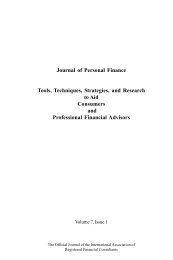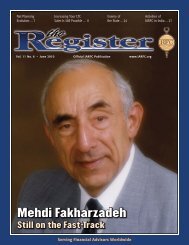3433-vol. 6 issue 2-3.pmd - iarfc
3433-vol. 6 issue 2-3.pmd - iarfc
3433-vol. 6 issue 2-3.pmd - iarfc
Create successful ePaper yourself
Turn your PDF publications into a flip-book with our unique Google optimized e-Paper software.
88<br />
Journal of Personal Finance<br />
The Transtheoretical Model of Change (TTM) and its<br />
Application to Debt Reduction<br />
The Transtheoretical Model of Change (TTM) was developed in the<br />
1970s (Prochaska, 1979). The Model was first applied to cessation of smoking,<br />
and then to a variety of other health-related behaviors including alcohol<br />
abuse, drug abuse, high fat diet and weight control, psychological distress,<br />
and sun exposure (Prochaska, Redding, Harlow, Rossi, & Velicer, 1994). A few<br />
studies applied the TTM to other areas, such as organizational change<br />
(Prochaska, 2000), collaborative service delivery (Levesque, Prochaska, &<br />
Prochaska, 1999), and domestic violence (Levesque, Gelles, & Velicer, 2000).<br />
The application of the TTM to debt reduction is a relatively new concept.<br />
The key constructs of the TTM include stages of change, processes<br />
of change, decisional balance, and self-efficacy. The five stages of change are:<br />
• Precontemplation (not intending to take action within the next 6<br />
months),<br />
• Contemplation (intending to take action within the next 6 months),<br />
• Preparation (intending to take action within the next 30 days),<br />
• Action (made overt changes less than six months ago), and<br />
• Maintenance (made overt changes more than six months ago).<br />
The ten processes of change are: consciousness-raising (CR), social<br />
liberation (SO), dramatic relief (DR), environmental reevaluation (ER), selfreevaluation<br />
(SR), self-liberation (SL), counter-conditioning (CC), stimulus<br />
control (SC), contingency management (CM), and helping relationships<br />
(HR). Table 1 presents definitions of the processes of change. In the early<br />
stages of change, people apply the experiential processes such as consciousness-raising,<br />
environment reevaluation, and dramatic relief to support their<br />
progress through the stages. The experiential processes are cognitive,<br />
affective, and evaluative. In the later stages, people rely more on the behavioral<br />
processes of counter-conditioning, contingency management, environmental<br />
controls, and social support for progressing toward termination (Pro-<br />
Change Behavior Systems, 2002). Figure 1 describes the theoretical relationship<br />
between stages of change and processes of change.<br />
©2008, IARFC All rights of reproduction in any form reserved.
















